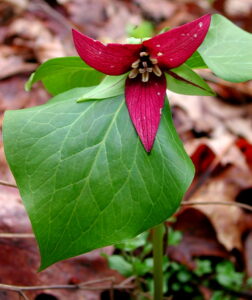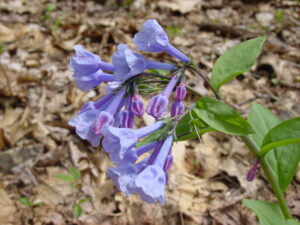Like all forests around us, the Schuylkill Center is in full bloom right now. You really have to see it to believe it. In fact, you can, if you simply walk down our Ravine Loop.
Like the red trillium (pictured below), an elusive and rare plant that New Englanders dubbed “wake robin,” as it bloomed there about when robins return north from their migrations (robins are year-round residents here in Roxborough).  Or the Virginia bluebells (pictured below)– one of everyone’s favorites, as it is taller than many of the spring ephemerals and one of the bluest of them all. You can find it on our Wildflower Loop and Ravine Loop, and it is happily one of our harder-to-miss wildflowers. I love its pink buds that open to blue flowers– two colors for the price of one.
Or the Virginia bluebells (pictured below)– one of everyone’s favorites, as it is taller than many of the spring ephemerals and one of the bluest of them all. You can find it on our Wildflower Loop and Ravine Loop, and it is happily one of our harder-to-miss wildflowers. I love its pink buds that open to blue flowers– two colors for the price of one.
But that’s just the beginning of the parade, starting right now. May apples are sending their bright green umbrella-shaped leaves up from the forest floor, soon sporting large white flowers. Soon bright yellow trout lilies will bloom, named for the spotting on their mottled leaves that resembles a trout’s back. And shooting stars, white flowers blazing across the forest floor. Jacob’s ladder, a complicated lilac-colored flower with ladder-ish leaves. Jack-in-the-pulpit, poking through the forest floor, Jack dutifully staying inside what looks like his mottled purple lectern. Solomon’s seal, named for the Biblical king, its delicate bell-like flowers dangling from zig-zags of leaves. Spring beauties, each petal a tiny white surfboard with a pink racing stripe down its middle.
And that’s just a start.
What’s amazing about these plants is the narrow window of time through which they slide. A forest in spring features trees without yet any leaves, so sunlight shines through and caresses the forest floor. Warmed by the sun, long-dormant roots and rhizomes suddenly come alive and send sprigs of growth up above the ground. These leaves photosynthesize– remember that from high school biology?– using sunlight to make sugars and send starches down into the rootstocks so they grow larger. When those rootstocks are large enough and have the resources, the plants send flowers into the world, often brightly colored to dazzle pollinating bees and butterflies.
And they coincidentally dazzle us too.
But the flowers are in a race against time– and the trees. As trees leaf out, those leaves block sunlight, form a sun-proof umbrella across the forest, and block those flowers from growing. So there is a small window of opportunity for the flowers to warm up, grow, make leaves, make flowers, get pollinated, drop seeds– and disappear for another year– before the trees leaf out.
We’ve already missed the earliest bloomers like bloodroot and skunk cabbage. But every day or every week you visit, new and different flowers will appear.
Stop in at our Visitor Center and grab a map, then head downhill through the butterfly meadow, turning left on the Ravine Loop and heading into the Wildflower Loop at Polliwog Pond. You’ll soon find a large stand of blue cohosh opposite oodles of shooting stars, with May apples, rue anemones, Dutchman’s breeches, and more spayed around you.
Walk downhill towards the loop’s back door on the Ravine Loop, then downhill again until it curves at Smith Run; the best wildflowers are on this section of trail parallelling the stream. You’ll pass tall leafed-out skunk cabbages on tour left, and tons of mottled trout lily leaves everywhere around you. Also on the left, here’s where you’ll find the best red trillium, and soon its close cousin, white trillium.
Spring wildflowers are racing the trees right now– come walk down our Ravine Loop and enjoy the race!
Mike Weilbacher directs the Schuylkill Center for Environmental Education in Roxborough, can be reached at mike@schuylkillcenter.org, and just authored the new book “Wild Philly,” of which this hike is the second of 25 nature walks. It’s currently available in our gift shop.

